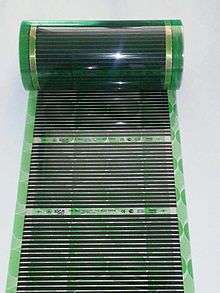Heating film

Heating films are one of the technics used for modern underfloor heating.
Description
It is intended to be a replacement for a conventional heating system, as a primary source. It's also used by many persons who want to build their own heating system that is not noticeable. The films can be placed or removed when needed. Some heating system controllers can allow the residents to select which surface will be heated.
Most of the heating films sold are based on a carbon film, a silver booth bar, copper foil booth placed under a Laminex film. This system is somehow similar to a secondary defogger that can be found in motor vehicles.
This heating system is mainly used in Asian countries like Korea, where it is considered as a modern version of ondol heating.[1][2][3] However, those films are semi-permanent, meaning that they need to be changed after a certain period of use, and are not widely available everywhere.

Ondol radiant floor heating
An ondol, also called gudeul (Korean: 구들), in Korean traditional architecture, is underfloor heating which uses direct heat transfer from wood smoke to the underside of a thick masonry floor. Many modern Korean houses use a radiant underfloor heating system that's called ondol, referring to the traditional ondol heating system. In fact, Korean people refer to any domestic heating system as ondol.
Technically, the modern day ondol is based on the same concept as the underfloor radiant heating invented by the American architect Frank Lloyd Wright, who was interested in Japanese architecture. Wright came with the idea while visiting a Japanese nobleman's house, where he found a tea room that was different from the rest of the house, using a Korean ondol as a heating system. He then took the same idea to create a heating system that fits American houses. Wright invented modern radiant floor heating, using hot water running through pipes instead of hot air through flues.[4]
A heating film, itself, is a variation of the modern ondol, but it doesn't require hot water and pipes as it is fully electric. There are also many variations of this underfloor heating system, as many underfloor heaters are based on PTC heating element, far-infrared rays, carbon film, or cables, etc.
Transparent heating film
Transparent heating films are a variant of the basic heating films but are built according to a different architecture. It consists of a thin and flexible polymer film with a conductive optical coating. These heating films can be used in museums as a replacement for heating tables [5]
References
- ↑ Ondol heating – Heating film | Heating Cable | Thermostats
- ↑ How do I use my heating? | whatawaygook
- ↑ Traditional Korean Heating System
- ↑ Radiant floor heating systems by Elektra and Ideal-Heating.com : ARTICLE 'The flow of ideas: From the West to the East and from the East to the West.'
- ↑ http://www.imatproject.eu/en/pld/conductive-transparent-film-heater-as-alternative-to-heating-table-towards-new-intelligent-mobile-accurate-thermo-electrical-imat-device-for-structural-conservation-of-paintings/23
External links
- http://www.heatingfilm.net/
- http://www.nrcan.gc.ca/energy/products/categories/heating/13740
- http://www.instructables.com/id/DIY-carbon-tape-heated-vest-modular-system/